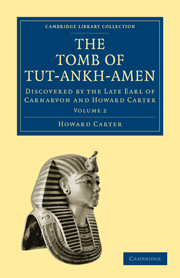Book contents
- Frontmatter
- PREFACE
- Contents
- LIST OF PLATES
- INTRODUCTION. REMARKS UPON EGYPTIAN ART
- CHAPTER 1 TUT-ANKH-AMEN
- CHAPTER 2 THE TOMB AND BURIAL CHAMBER
- CHAPTER 3 CLEARING THE BURIAL CHAMBER AND OPENING THE SARCOPHAGUS
- CHAPTER 4 THE STATE CHARIOTS
- CHAPTER 5 THE OPENING OF THE THREE COFFINS (SEASON 1925–26)
- CHAPTER 6 POINTS OF INTEREST IN EGYPTIAN BURIAL CUSTOMS
- CHAPTER 7 THE EXAMINATION OF THE ROYAL MUMMY
- APPENDICES
- INDEX
- Plate section
- Plate section
CHAPTER 3 - CLEARING THE BURIAL CHAMBER AND OPENING THE SARCOPHAGUS
Published online by Cambridge University Press: 05 March 2012
- Frontmatter
- PREFACE
- Contents
- LIST OF PLATES
- INTRODUCTION. REMARKS UPON EGYPTIAN ART
- CHAPTER 1 TUT-ANKH-AMEN
- CHAPTER 2 THE TOMB AND BURIAL CHAMBER
- CHAPTER 3 CLEARING THE BURIAL CHAMBER AND OPENING THE SARCOPHAGUS
- CHAPTER 4 THE STATE CHARIOTS
- CHAPTER 5 THE OPENING OF THE THREE COFFINS (SEASON 1925–26)
- CHAPTER 6 POINTS OF INTEREST IN EGYPTIAN BURIAL CUSTOMS
- CHAPTER 7 THE EXAMINATION OF THE ROYAL MUMMY
- APPENDICES
- INDEX
- Plate section
- Plate section
Summary
The second season's work actually began in the laboratory, under Mr. Mace, who dealt with the magnificent chariots and the ceremonial couches that were left over from the first season. While he was carrying out this work of preservation and packing, with the aid of Mr. Callender, I began by removing the two guardian statues (Plate IX) that stood before the doorway of the Burial Chamber, and then, as it was necessary, demolished the partition wall dividing it from the Antechamber (Plate X).
Without first demolishing that partition wall, it would have been impossible to have dealt with the great shrines within the Burial Chamber, or to remove many of the funereal paraphernalia therein. Even then our great difficulty was due to the confined space in which we had to carry out the most difficult task of dismantling those shrines, which proved to be four in number, nested one within the other.
Beyond the very limited space and high temperature which prevailed, our difficulties were further increased by the great weight of the various sections and panels of which those complex shrines were constructed. These were made of 2¼-inch oak planking, and overlaid with superbly delicate gold-work upon gesso. The wood-planking, though perfectly sound, had shrunk in the course of three thousand three hundred years in that very dry atmosphere, the gold-work upon the gesso had, if at all, slightly expanded; the result in any case was a space between the basic wood-planking and the ornamented gold surface which, when touched, tended to crush and fall away.
- Type
- Chapter
- Information
- The Tomb of Tut-Ankh-AmenDiscovered by the Late Earl of Carnarvon and Howard Carter, pp. 39 - 53Publisher: Cambridge University PressPrint publication year: 2010First published in: 1927



